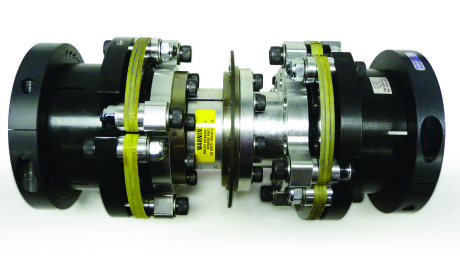High Torsional Stiffness And High Load Capacity are Key CD® Coupling Performance Features
Test Dynamometers experience high input speeds and high torque loads which cause stress on transducers and connected components. To assure these systems generate accurate performance information when experiencing these conditions, system designers specify CD® Couplings from Zero-Max.

CD Couplings are unique in design and can provide the ideal combination of operating characteristics that will improve the accuracy of torque measurement. Making this possible is the coupling’s proprietary Composite Disc pack. The key characteristics of the Composite Disc design are:
- High Torsional Stiffness
- Low reaction loads under (inevitable) misalignment
- Medium Axial Stiffness
These properties when employed in a Test Dynamometer will result in the following benefits:
- Predictable axial natural frequency (ANF)
The axial stiffness is highly linear because of the properties of the composite material and the shape of the flex element. The Composite Disc has very high torsional stiffness and at the same time a highly linear axial stiffness. These properties will provide for a more predictable ANF point.
It is often possible for Zero-Max engineers to design a coupling system that will work with a customer specified torque transducer and keep the ANF point above the system speed. This eliminates the issue of vibration due to passing though the ANF band, and allows operation at any speed up to the system’s maximum specified speed.
- Reduced stress on connecting torque transducers
A characteristic of the open arm design of the Composite Disc flex element is a low reaction load under misalignment. This will greatly reduce unnecessary loading on the torque transducer, thus greatly increasing the accuracy of the overall system.
- Shorter and smaller overall design for system space savings
The Composite Disc design is such that it can flex well over 2 degrees without fatigue and without compromising operational life. With this increased angular capacity, along with the low reaction loads under misalignment, the length needed to accommodate the required radial misalignment, or keep reaction loads to a minimum, is significantly less than a comparable metallic flex element. The result is a much more compact assembly with less vibration issues overall.
Couplings designed for Test Dynamometer applications are often custom designed to the specific needs of the test machine, and can be adapted to shafted or flange-mount transducers. The technology of the Composite Disc design and the application acumen of Zero-Max Engineers work together to provide a superior solution for the demanding needs of Test Dynamometers.
See at: www.zero-max.dk
Or call for FREE brochure, (45) 8681 2288 or write to Zero-Max A/S, email: ext@zero-max.dk



